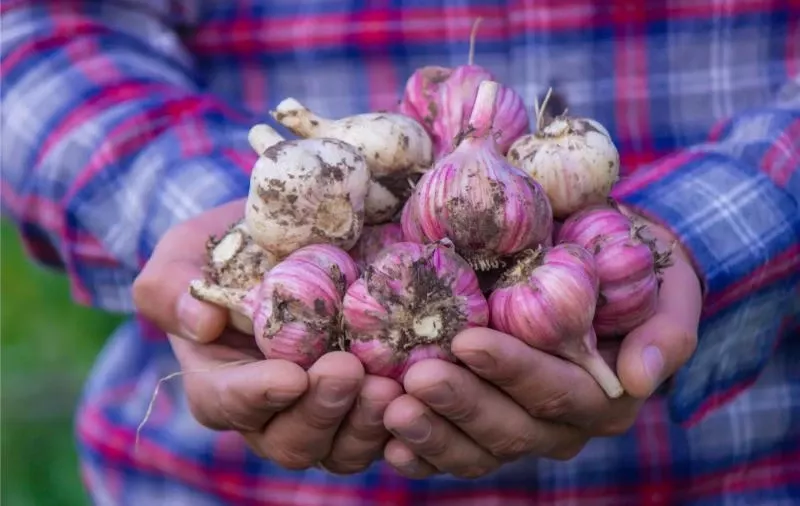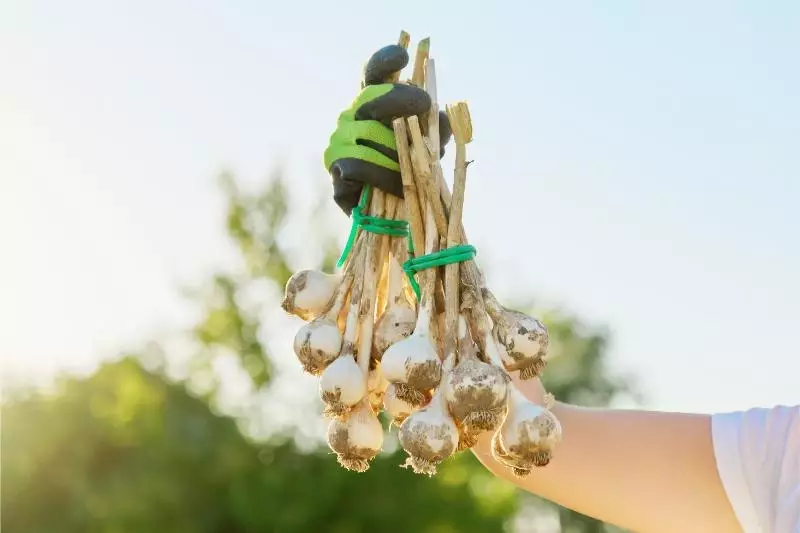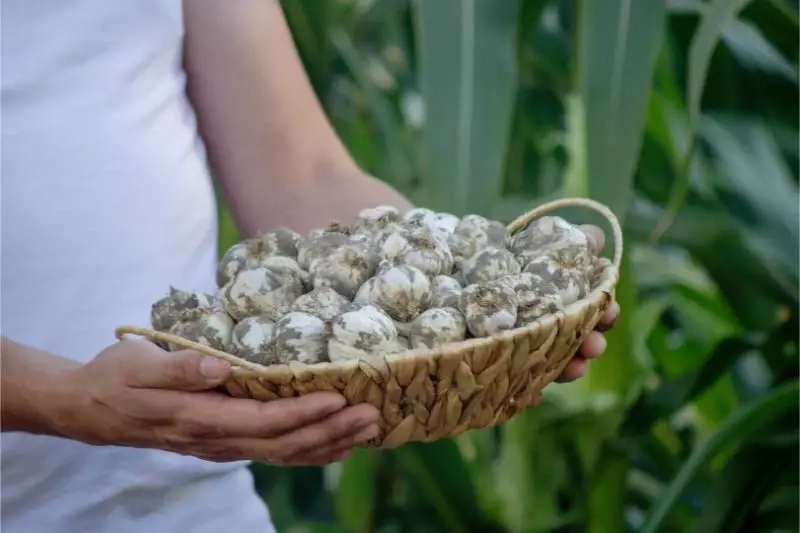Why Is Seed Garlic So Expensive? (Where to Buy It)
Since seed garlic is propagated vegetatively, meaning it's grown from cloves instead of seeds, the genetics of each clove are identical to the parent plant. This ensures that the traits of the garlic such as size, flavor, and robustness are preserved and passed on. With this in mind, purchasing premium seed garlic, despite its more expensive pricing, can be seen as investing in a garlic crop that will be healthy, consistent, and bountiful.
Seed garlic is expensive due to its specialized breeding for disease resistance and quality, requiring more labor and resources. You can buy it from reputable nurseries, online gardening stores, or dedicated garlic farms. Look for suppliers that offer certified organic, disease-free options to ensure healthy bulbs to plant.
Unlike regular garlic, seed garlic is grown with the intention of agricultural perfection, ensuring each clove is a robust foundation for future harvests. This involves careful selection processes, where only the healthiest, most resilient cloves are chosen, often by hand, to guarantee superior growth and disease resistance.
Summary
- The cost of seed garlic, ranging from $12 to $25 per pound, reflects its specialized breeding for disease resistance and quality, involving labor-intensive selection processes and careful nurturing to maintain superior growth and robustness.
- Seed garlic offers advantages over store-bought garlic, including larger size, better yield potential, and disease resistance, justifying its higher price due to the extensive labor and resources dedicated to its cultivation.
- While seed garlic is primarily intended for planting due to its superior quality and genetic traits, it can be consumed just like regular garlic, offering the same taste and health benefits, although its primary value lies in gardening.

On this page:
Seed Garlic Is a Significant Investment
Seed garlic isn't just any garlic; it represents the best of the harvest with more substantial bulbs, chosen for their superior size, quality, and disease resistance.
Investing in quality seed garlic is essential for gardeners and farmers who are looking for a successful harvest. It's not just garlic for culinary use; seed garlic is a premium product specifically meant for planting. Quality matters, and the healthiest, largest bulbs are selected to ensure a good crop, justified by the higher cost you pay for this gardening input.
Growing seed garlic is more than just planting and watering; it involves thorough selection and nurturing to meet the standards required for optimal growth. This labor-intensive process contributes to the cost—essentially, you're paying for the extra care and attention each bulb has received. It's a purchase toward a future of robust garlic plants in your own garden.
| Comparison | Seed Garlic | Store-Bought Garlic |
|---|---|---|
| Quality | Often larger and more robust, ensuring a better yield | Can vary greatly; smaller cloves may lead to less vigorous plants |
| Flavor | Tends to be fresher with more varieties available, potentially enhancing flavor profiles | Aimed for immediate consumption, which might not translate to the same level of taste once grown |
| Chemicals | Generally free from growth inhibitors, allowing for natural sprouting when planted | Might contain chemicals to prevent sprouting, affecting germination when planted |
| Diseases | More resistant to diseases, as care is taken to ensure the health of the crops | Higher risk of carrying diseases that can spread to your garden |
The profit margin for garlic farming businesses in the US ranges from 25% to 45%. After costs, garlic growers had an overall gross margin of 34% according to this University of Minnesota study.

How much does seed garlic cost?
Seed garlic typically falls within the range of $12 to $25 per pound, contrasting with standard garlic you might find at the grocery store, which generally costs between $2 and $6 per pound.
- Seed garlic bulbs - $15 to $25 per pound retail. Wholesale prices for commercial growers may be $8 to $15 per pound.
- Seed garlic cloves - $0.25 to $0.60 per clove retail. Wholesale prices around $0.15 to $0.30 per clove.
Factors Driving Up Seed Garlic Prices
These include the substantial labor involved in cultivation, rigorous measures to prevent disease, and the challenges related to storage and maintaining viability.
Labor and harvesting costs
The planting and harvesting process for seed garlic requires more manual labor. Each clove is often planted by hand to ensure the best growth conditions.
| Activity | Time Range | Cost Range | Total Cost |
|---|---|---|---|
| Planting | 10–20 hrs/acre | $15–25 per hour | $150–500 per acre |
| Tending and weed control | 15–30 hrs/acre | $15–25 per hour | $225–750 per acre |
| Harvesting | 20–40 hrs/acre | $15–25 per hour | $300–1,000 per acre |
Prevention and control of diseases
Pesticides and fertilizers are often used more intensively compared to regular crops to ensure the highest quality bulbs.
| Prevention Measures | Estimated Cost |
|---|---|
| Disease-free stock | $500–1,000 per acre |
| Monitoring and testing | $100–300 per acre |
Storage and viability challenges
After harvest, seed garlic requires proper storage to maintain quality. Controlled environments prevent spoilage and loss of planting quality, which can add to the overhead costs.
| Storage Solutions | Additional Cost Range |
|---|---|
| Controlled climate | $200–500 per acre |
| Regular monitoring | $50–150 per acre |
The Market for Seed Garlic
When exploring the market for seed garlic, you'll find that it is driven primarily by the specific demands of gardeners and farmers, and there is a marked preference for buying local for both quality and community support reasons.
Seed garlic is valued for its superior flavor and variety potential. Garlic farmers select the best cloves for planting, which results in a greater yield and better sprouting rates. This careful selection often leads to fewer stems per pound and thus, impacts cost.
Distinct varieties of seed garlic can adapt to different climates and cuisines preferences, which influence their market value. Some varieties are more popular in restaurants and among gourmet chefs, which can trigger shifts in demand. Supermarkets and grocers follow suit, further straining the supply and pushing up prices.
| Seed Garlic Variety | Price per Pound |
|---|---|
| Music | $18 to $22 |
| German Extra Hardy | $15 to $20 |
| California Early | $15 to $18 |
| Inchelium Red | $20 to $25 |
| Persian Star | $12 to $15 |
| Rocambole | $22 to $28 |
| Artichoke | $25 to $30 |
| Silverskin | $10 to $14 |
| Chesnok Red | $18 to $22 |
| Korean Purple | $15 to $20 |
Supply chains play a significant role too. Logistical challenges and the cost to ensure seed garlic remains viable for planting contribute to the overall expense. Each link in the chain, from the farmer to your local supermarket, adds a markup to cover these special requirements.
How long does seed garlic last?
The longevity of seed garlic is crucial for your planting timeline. Typically, high-quality seed garlic can last up to eight months when stored properly in a cool, dry place.
However, since seed garlic is sold in a market where supply chains have been impacted by the COVID-19 pandemic, local farms that produce this sought-after commodity face increased production costs. These costs are passed on to you, whether you're purchasing from supermarkets, grocers, or directly from a farm.
Where Is Seed Garlic Grown
-
Local climate: Seed garlic prefers a specific climate—milder weather is better for softneck varieties, while hardneck types thrive in colder conditions. The USDA hardiness zones that are best suited for growing garlic are zones 4 to 9.
-
Growing period: Seed garlic requires a longer growing period than regular garlic. This means that in regions with shorter growing seasons, you might need to employ techniques like using mulch to extend the growing time, adding to the costs.
-
Space requirements: Each garlic type has different space needs to grow efficiently. Hardneck varieties, for instance, often demand more room because of their larger size, increasing the land cost for farmers.

Where to buy seed garlic
When you’re looking for seed garlic, consider local nurseries or farmers' markets first. These venues typically offer varieties that are well-suited to your region's climate, which can be a major advantage for growing robust garlic bulbs.
You can also check out online retailers specializing in seed garlic; some well-known seed companies include:
Some agricultural extension services and university horticulture programs sell seed garlic or can recommend where to buy quality seed garlic in your region.
Local gardening clubs and societies often have plant sales or swaps where you can purchase seed garlic. These can be great places to find varieties that do well in your area and get planting advice from experienced gardeners.
Farms specializing in garlic production often sell seed garlic directly to consumers. Buying from these farms can provide access to high-quality, organic, and specialty varieties that are hard to find elsewhere.
Benefits of buying local seed garlic
By choosing to buy local seed garlic, you're not only receiving a product that's acclimated to your region's climate, but also supporting your local farm economy.
Local seed garlic is often fresher and more diverse in variety compared to what's available on the larger market. Moreover, buying local allows you to establish a direct relationship with the producer, potentially leading to better prices and firsthand growing tips.

Commercial Farming and Scaling
Hardneck garlic, valued for its flavor, is more labor-intensive than softneck, impacting your investment. You'll need to account for the extended growing time and meticulous care to produce a profitable yield.
Scaling up necessitates a focus on supply chain efficiency. More produce means dealing with bulk storage and transportation logistics to ensure timely delivery to the market. You might invest in machines to crack bulbs and plant, as in the case of Minnesota's largest market garlic grower.
Benefits of one seed garlic
The term "one seed garlic" could refer to a garlic variety that tends to produce a single, large clove per bulb, rather than the typical multiple cloves. These are often referred to as "solo garlic" or "single clove garlic" and are less common than the multi-cloved varieties. Here are some benefits of growing and using one seed (solo) garlic:
-
Ease of peeling and preparation: With just one clove per bulb, solo garlic is much easier to peel and prepare for cooking compared to multi-clove garlic bulbs. This convenience can save time and effort in the kitchen.
-
Uniform cooking: The uniform size and shape of solo garlic cloves can contribute to more consistent cooking, as each piece is essentially the same size. This is particularly beneficial in dishes where garlic is a featured ingredient.
-
Unique flavor profile: Some solo garlic varieties may offer a unique or milder flavor compared to traditional garlic, which can be desirable in certain culinary applications. The flavor tends to be less intense, which can be advantageous in dishes where a subtler garlic presence is preferred.
-
Novelty and presentation: The unusual appearance of solo garlic can add a novelty factor to dishes, making it a conversation starter or an interesting addition to specialty food baskets and culinary presentations.
-
Potential health benefits: Like traditional garlic, solo garlic is rich in vitamins and minerals, and has the potential to offer various health benefits, including immune system support, improved heart health, and antibacterial properties. Its consumption might provide similar health advantages, albeit with a different taste and usage profile.
-
Ease of storage: The single-clove structure may contribute to an extended shelf life under optimal conditions, as there are fewer cuts or breaks in the skin that could lead to spoilage.
-
Agricultural diversity: Growing solo garlic can add diversity to a garden or farm, offering a different type of crop to cultivate. This diversity can be beneficial for soil health and pest management.
-
Market demand: For farmers and gardeners, growing solo garlic can tap into niche markets looking for unique or specialty garlic varieties. The distinctiveness of one seed garlic can make it a sought-after item at farmers' markets and specialty stores.
Can you eat seed garlic?
Yes, you can eat seed garlic. It's the same species as regular garlic but selected for planting due to its large size and health. Eating seed garlic offers the same taste and health benefits as regular garlic, though its primary purpose is for gardening to ensure a robust and healthy crop. You're paying for superior genetics because of this purpose.



